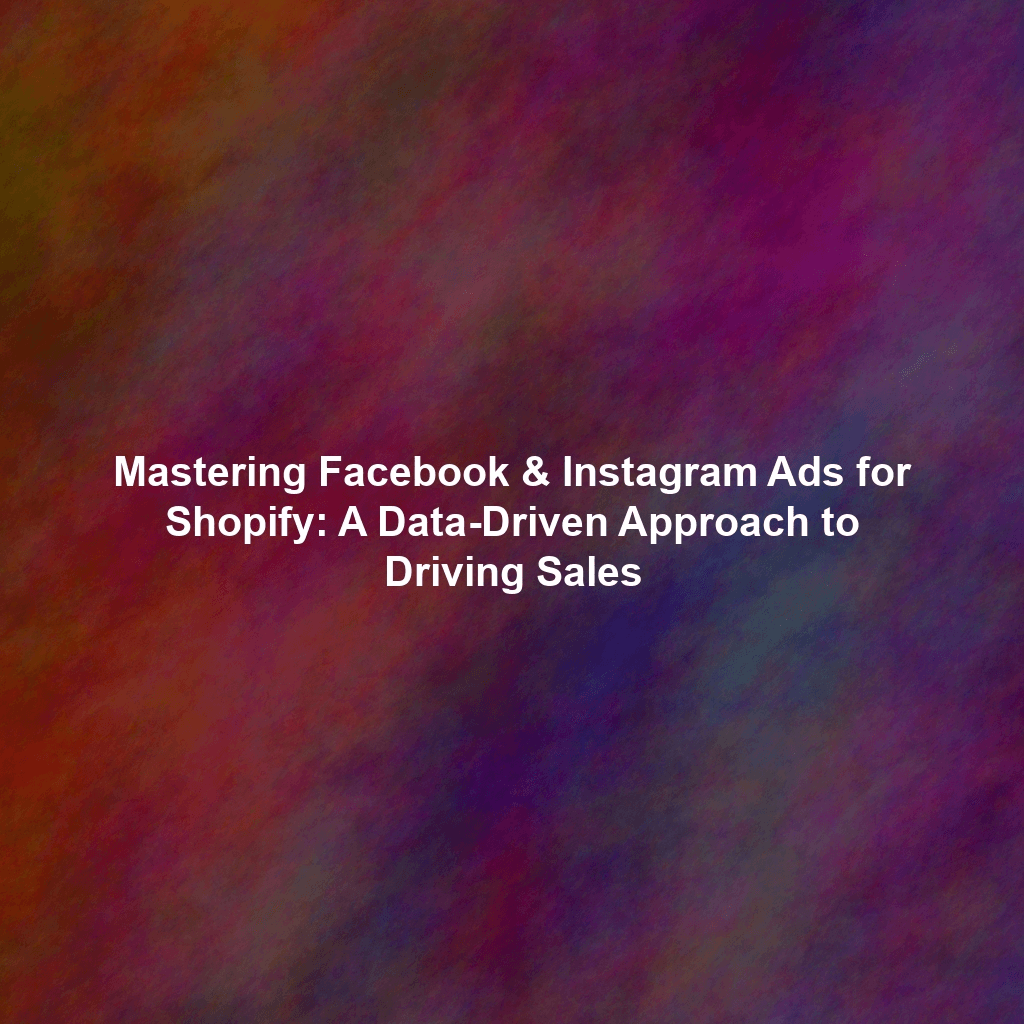Setting Up for Success: The Foundation of Your Ad Campaigns
1. Installing and Configuring the Facebook Pixel
The Facebook Pixel is the cornerstone of data tracking. It’s a snippet of code that you install on your Shopify store to track user behavior, such as page views, add-to-carts, and purchases. This data is crucial for understanding how your ads are performing and optimizing your campaigns. To install the pixel:
- Go to your Facebook Ads Manager and create a Pixel.
- Shopify has built-in integration! In your Shopify admin, go to Online Store > Preferences.
- Scroll down to the Facebook Pixel section and paste your Pixel ID.
- Verify the Pixel is working correctly using the Facebook Pixel Helper Chrome extension.
2. Defining Your Target Audience
Before you even create an ad, you need to know who you’re targeting. Facebook’s audience targeting options are incredibly granular, allowing you to reach specific demographics, interests, and behaviors. Consider these targeting methods:
- Demographics: Age, gender, location, education, income, etc.
- Interests: Hobbies, passions, and pages they follow.
- Behaviors: Purchase history, device usage, and online activities.
- Lookalike Audiences: Create audiences similar to your existing customers, website visitors, or email subscribers. This is a powerful way to expand your reach.
- Custom Audiences: Upload your customer lists (email addresses, phone numbers) to target them directly or create Lookalike Audiences.
Pro Tip: Start with broader targeting and gradually narrow down your audience based on performance data. A/B test different audience segments to see which performs best.
Crafting Compelling Ads: Engaging Your Target Audience
1. Ad Creative Best Practices
Your ad creative is what grabs attention and convinces people to click. Here are some best practices:
- High-Quality Visuals: Use professional-looking photos or videos that showcase your products in the best light.
- Compelling Headlines: Write headlines that are attention-grabbing, clear, and relevant to your target audience.
- Benefit-Driven Copy: Focus on the benefits of your products, not just the features. How will your product solve a problem or improve their lives?
- Clear Call-to-Action: Tell people what you want them to do (e.g., “Shop Now,” “Learn More,” “Get Yours Today”).
- Mobile Optimization: Ensure your ads look good on mobile devices, as most users will be seeing them on their phones.
2. A/B Testing Your Ads
Don’t assume you know what will work best. A/B test different ad elements, such as headlines, images, and call-to-actions, to see which combinations perform best. Facebook’s ad platform makes A/B testing easy.
3. Choosing the Right Ad Format
Facebook and Instagram offer various ad formats, including:
- Image Ads: Simple and effective for showcasing a single product.
- Video Ads: More engaging and can be used to tell a story about your brand.
- Carousel Ads: Allow you to showcase multiple products in a single ad.
- Collection Ads: Visually appealing and allow users to browse your products directly from the ad.
- Instant Experience Ads: Full-screen, mobile-optimized ads that provide an immersive experience.
Retargeting Strategies: Bringing Back Lost Customers
1. Targeting Website Visitors
Retargeting is showing ads to people who have already interacted with your Shopify store. For example, you can retarget users who:
- Visited specific product pages.
- Added items to their cart but didn’t complete the purchase.
- Viewed your website but didn’t make any purchases.
2. Creating Specific Retargeting Ads
Retargeting ads should be highly relevant to the user’s past behavior. For example, if someone added an item to their cart but didn’t purchase, show them an ad featuring that specific item and offer a discount or free shipping.
3. Excluding Purchasers
It’s crucial to exclude people who have already purchased the product you’re advertising. Otherwise, you’ll be wasting your ad spend and potentially annoying your customers.
Data-Driven Optimization: Refining Your Campaigns for Maximum ROAS
1. Tracking Key Metrics
Monitor the following metrics to assess the performance of your campaigns:
- Return on Ad Spend (ROAS): The most important metric. It measures the revenue generated for every dollar spent on ads.
- Cost Per Acquisition (CPA): The cost of acquiring a new customer.
- Click-Through Rate (CTR): The percentage of people who see your ad and click on it.
- Conversion Rate: The percentage of people who visit your website and make a purchase.
- Cost Per Click (CPC): The cost of each click on your ad.
2. Analyzing Your Data
Use Facebook Ads Manager to analyze your data and identify trends. Which ads are performing best? Which audiences are most responsive? Use these insights to make adjustments to your campaigns.
3. Continuous Improvement
Running successful Facebook and Instagram ad campaigns is an ongoing process. Continuously test new ideas, analyze your data, and optimize your campaigns to improve your ROAS. Consider these strategies:
- Bid Adjustments: Increase bids for high-performing audiences and decrease bids for low-performing audiences.
- Ad Creative Refresh: Keep your ads fresh by regularly updating your visuals and copy.
- Landing Page Optimization: Ensure your landing pages are optimized for conversions.
Conclusion: Embrace the Power of Data
Mastering Facebook and Instagram ads for your Shopify store requires a commitment to data-driven decision-making. By implementing the strategies outlined in this guide – from setting up your pixel to crafting compelling ads and continuously optimizing your campaigns – you can significantly improve your return on ad spend and drive more sales for your business. Remember to constantly learn, adapt, and experiment to stay ahead of the curve in the ever-evolving world of social media advertising. Good luck!
 Skip to content
Skip to content

